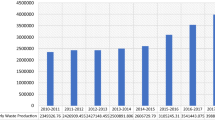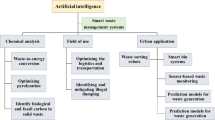Abstract
In waste recycling, the source separation model, decentralises the sorting responsibility to the consumer when they dispose, resulting in lower cross contamination, significantly increased recycling yield, and superior recovery material quality. This recycling model is problematic however, as it is prone to human error and community-level participation is difficult to incentivise with the greater inconvenience being placed on consumers. This paper aims to conceptualise a solution by proposing a unique mechatronic system in the form of a self-sorting smart bin. It is hypothesised that in order to overcome the high variability innate to disposed waste, a robust supervised machine learning classification model supported by IoT integration needs to be utilised. A dataset comprising of 680 samples of plastic, metal and glass recyclables was manually collected from a custom-built identification chamber equipped with a suite of sensors. The dataset was then split and used to train a modular neural network comprising of three concurrent individual classifiers for images (CNN), sounds (MLP) and time series (KNN-DTW). The output class probabilities were then integrated by one combined classifier (MLP), resulting in a prediction time of 0.67 s per sample, a prediction accuracy of 100%, and an average confidence of 99.75% averaged over 10 runs of an 18% validation split.
Access this chapter
Tax calculation will be finalised at checkout
Purchases are for personal use only
Similar content being viewed by others
References
Hoornweg, D., Bhada-Tata, P.: What A Waste - A Global Review of Solid Waste Management. The World Bank, Washington (2012)
Smith, K., O’Farrell, K., Brindley, F.: Department of Sustainability, Environment, Water, Population and Communities - Waste and Recycling in Australia 2011. Hyder Consulting Pty Ltd, North Sydney (2011)
Peacock, D.: ReLoop: What is Single Stream Recycling. http://greenblue.org/reloop-what-is-single-stream-recycling/
Khanna, P.: Urbanisation, Technology, and the Growth of Smart Cities. Singapore Management University. https://cmp.smu.edu.sg/ami/article/20161116/urbanisation-technology-and-growth-smart-cities
Peacock, D.: ReLoop: What is Source Separated Recycling. http://greenblue.org/reloop-what-is-source-separated-recycling/
GreenCan: MHacks. https://mhacks.devpost.com/submissions/17562-greencan
Bradley, H.: Automated Waste Sorting Receptacle (Full Demo). https://www.youtube.com/watch?v=v95Ifjz9sSg
Tarbell, K.A., Tcheng, D.K., Lewis, M.R., Newell, T.A.: Applying Machine Learning to the Sorting of Recyclable Containers. University of Illinois Urbana-Champaign, Urbana (1992)
Durrant-Whyte, H.: Multi Sensor Data Fusion. Australian Centre for Field Robotics, Sydney (2001)
Haik, Y., Shahin, T.M.: Engineering Design Process, 2nd edn. Cengage Learning, Stamford (2011)
Tensorflow - retrain.py. https://github.com/tensorflow/tensorflow/blob/master/tensorflow/examples/image_retraining/retrain.py
Raval, S.: Build a TensorFlow Image Classifier in 5 Min. https://www.youtube.com/watch?v=QfNvhPx5Px8
Saeed, A.: Urban Sound Classification, Part 1 - Feature extraction from sound and classification using Neural Networks. https://aqibsaeed.github.io/2016-09-03-urban-sound-classification-part-1/
Kinsley, H.: Deep Learning with TensorFlow - How the Network will run. https://pythonprogramming.net/tensorflow-neural-network-session-machine-learning-tutorial/?completed=/tensorflow-deep-neural-network-machine-learning-tutorial/
Regan, M.: K Nearest Neighbours & Dynamic Time Warping. https://github.com/markdregan/K-Nearest-Neighbors-with-Dynamic-Time-Warping
Author information
Authors and Affiliations
Corresponding author
Editor information
Editors and Affiliations
Rights and permissions
Copyright information
© 2020 Springer Nature Switzerland AG
About this paper
Cite this paper
Chan, T., Cai, J.H., Chen, F., Chan, K.C. (2020). Self-sorting of Solid Waste Using Machine Learning. In: Hernes, M., Wojtkiewicz, K., Szczerbicki, E. (eds) Advances in Computational Collective Intelligence. ICCCI 2020. Communications in Computer and Information Science, vol 1287. Springer, Cham. https://doi.org/10.1007/978-3-030-63119-2_5
Download citation
DOI: https://doi.org/10.1007/978-3-030-63119-2_5
Published:
Publisher Name: Springer, Cham
Print ISBN: 978-3-030-63118-5
Online ISBN: 978-3-030-63119-2
eBook Packages: Computer ScienceComputer Science (R0)




